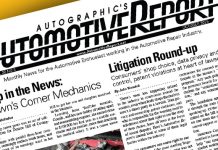By John Yoswick
Technical work that involves more than fixing dents and spraying paint is becoming a larger and larger part of collision repair. Scanning, calibrations and other work for advanced driver assistance systems (ADAS) are often adding a significant number of lines to estimates or repair invoices — or should be. In addition to the technical challenges of finding the expertise — either in-house or through a dealer or sublet vendor — to do this work, shops also need to learn how to do the work profitably.
Here are some business angles and pricing practices to consider to help make the work necessary related to this vehicle technology pay off.
Understand the trends
Collision repair businesses are all over the map in terms of how they getting ADAS-related work done. Many scan vehicles in-house; others use remote scanning services. Subletting calibrations to a dealer or a mobile service is common. But many shops are seeing the downsides of not being able to do this work in-house — including leaving money on the table. The owner of a four-shop collision repair business in the South did the math and realized his company spent $1.7 million on calibration sublet work last year — and has decided to build his own stand-alone repair center to do that work.
Others question whether automakers will adjust the vehicle technology in ways that reduce the amount of ADAS calibration work is necessary, making it hard to get a return on an investment in all that’s necessary to do the work in-house. But Nick Dominato, a senior vice president at asTech, foresees ADAS calibration requirements expanding, not declining.
“Because the automakers understand that vehicles are being marketed, sold, driven and experienced via those advanced driver assistance features, and it’s important for …



